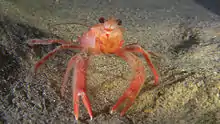Grimothea planipes
Grimothea planipes, also known as the pelagic red crab, red crab, or tuna crab, is a species of squat lobster from the eastern Pacific Ocean.
| Grimothea planipes | |
|---|---|
 | |
| Scientific classification | |
| Domain: | Eukaryota |
| Kingdom: | Animalia |
| Phylum: | Arthropoda |
| Class: | Malacostraca |
| Order: | Decapoda |
| Suborder: | Pleocyemata |
| Infraorder: | Anomura |
| Family: | Munididae |
| Genus: | Grimothea |
| Species: | G. planipes |
| Binomial name | |
| Grimothea planipes (Stimpson, 1860) | |
| Synonyms | |
| |
Description
Grimothea planipes is a bright red animal, up to 13 centimetres (5.1 in) long.[1] It resembles a true lobster, but has a shorter abdomen.[2]
Distribution
Grimothea planipes lives on the continental shelf west of Mexico.[3] It is usually found only south-west of San Diego,[1] but in warmer years, its range may extend northwards into California.[3] This is usually indicative of an El Niño event.[4] Adults migrate vertically to near the ocean surface and large numbers occasionally wash up on beaches during warm water events.[3] The southern limit of the species' range is in Chile.[5]
Life cycle
The life cycle of Grimothea planipes appeared for a long time to form a paradox: while an adult population was maintained along the south-western coast of the United States, the planktonic larvae they released were immediately swept by the California Current thousands of miles out to sea. A solution was proposed whereby the larvae use an opposing undercurrent at a lower depth to return to the continental shelf, and this hypothesis was confirmed by sampling different depths of water with a plankton recorder.[6]
Ecology
Grimothea planipes usually feeds on protists and zooplankton, but will feed by filtering blooms of diatoms.[7]
As the most abundant species of micronekton in the California Current, Grimothea planipes fills an important ecological niche converting primary production into energy that larger organisms can use.[8] G. planipes is accordingly an important food item for many species of birds, marine mammals and fish. It is favoured by tuna, leading to one of the species' common names – "tuna crab".[1] Other fish known to feed on G. planipes include billfishes, yellowtail amberjack, sharks[9] and Epinephelus analogus.[10] The diets of gray whales,[11] Bryde's whales,[12] blue whales[12] and sea otters[13] all include G. planipes. The Mexican endemic bat Myotis vivesi also feeds on G. planipes at some times of the year.[14] Off Baja California, the stomachs of some loggerhead sea turtles have been observed to contain only G. planipes.[15] Since G. planipes may be washed ashore in large numbers, it can be a valuable addition to the diets of seabirds such as the herring gull (Larus argentuatus), whose food supply is usually diminished in El Niño years.[16]
References
- Sam Hinton (1987). "Phylum Arthropoda ("joint-limbed animals")". Seashore Life of Southern California: an Introduction to the Animal Life of California Beaches South of Santa Barbara. Issue 26 of California Natural History Guides (2nd ed.). University of California Press. pp. 131–161. ISBN 978-0-520-05924-5.
- Wheeler J. North (1976). "Marine animals: arthropod crustacea, echinoderms, and tunicates". Underwater California. Volume 39 of California Natural History Guides. University of California Press. pp. 207–231. ISBN 978-0-520-03039-8.
- Janet Haig & Donald P. Abbott (1980). "Macrura and Anomura: the ghost shrimps, hermit crabs, and allies". In Robert Hugh Morris; Donald Putnam Abbott & Eugene Clinton Haderlie (eds.). Intertidal Invertebrates of California. Stanford University Press. pp. 577–593. ISBN 978-0-8047-1045-9.
- Ronald H. McPeak; Dale A. Glantz; Carole R. Shaw (1988). "The ever-changing forest". The Amber Forest: Beauty and Biology of California's Submarine Forests. Aqua Quest Publications. pp. 32–41. ISBN 978-0-922769-00-1.
- Kareen Schnabel & Amelia Connell (2007). "Lobster à la carte". Water & Atmosphere. 15 (4).
- Ernest Naylor (2010). "Plankton vertical migration rhythms". Chronobiology of Marine Organisms. Cambridge University Press. pp. 134–149. ISBN 978-0-521-76053-9.
- Alan R. Longhurst, Carl J. Lorenzen & William H. Thomas (1967). "The role of pelagic crabs in the grazing of phytoplankton off Baja California". Ecology. 48 (2): 190–200. doi:10.2307/1933100. JSTOR 1933100.
- Carlos J. Robinson; Vicente Anislado; Antonio Lopez (2004). "The pelagic red crab (Pleuroncodes planipes) related to active upwelling sites in the California Current off the west coast of Baja California". Deep Sea Research Part II: Topical Studies in Oceanography. 51 (6–9): 753–766. doi:10.1016/j.dsr2.2004.05.018.
- Michael H. Horn & Lara A. Ferry-Graham (2006). "Feeding mechanisms and trophic interactions". In Larry Glenn Allen; Daniel J. Pondella & Michael H. Horn (eds.). Ecology of Marine Fishes: California and Adjacent Waters. University of California Press. pp. 387–410. ISBN 978-0-520-24653-9.
- Susan M. Luna & Nicolas Bailly (October 6, 2010). "Epinephelus analogus Gill, 1863, spotted grouper". FishBase. Retrieved February 15, 2011.
- Robert Busch (1998). "The nature of the beast". Gray Whales: Wandering Giants. Heritage House Publishing. pp. 1–66. ISBN 978-1-55143-114-7.
- Mercedes Guerrero, Jorge Urbán y Lorenzo Rojas (2006). "Conocimiento biológico de los cetáceos del Golfo de California". Las Ballenas del Golfo de California (in Spanish). Instituto Nacional de Ecología. pp. 157–406. ISBN 978-968-817-761-7.
- James L. Bodkin (2003). George A. Feldhamer; Bruce Carlyle Thompson; Joseph A. Chapman (eds.). Wild Mammals of North America: Biology, Management, and Conservation (2nd ed.). JHU Press. pp. 735–743. ISBN 978-0-8018-7416-1.
- William Lopez-Forment. "January 6, 2011. Isla Monserrat & Isla del Carmen". Daily Expedition Reports. Lindblad Expeditions & National Geographic. Archived from the original on July 10, 2011. Retrieved February 15, 2011.
- "Caretta caretta (Linnaeus, 1758)". Species Fact Sheets. Food and Agriculture Organization. Retrieved February 15, 2011.
- Brent S. Stewart, Pamela K. Yochem & Ralph W. Schreiber (1984). "Pelagic red crabs as food for gulls: a possible benefit of El Niño" (PDF). The Condor. 86 (3): 341–342. doi:10.2307/1367007. JSTOR 1367007.